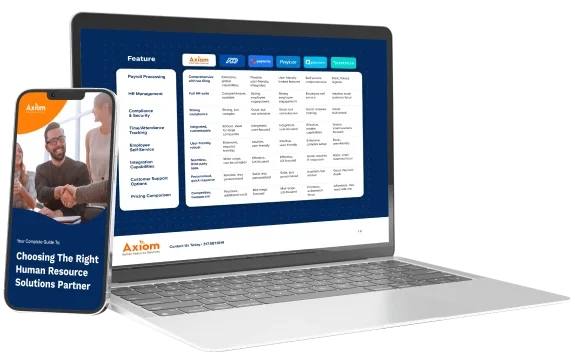
Strategic decision-making drives long-term success and sustainability for your organization. When you are making informed decisions, you are helping your organization meet goals, gain a competitive edge, and make the most of resources to boost your bottom line. The more informed your decisions, the more the organization grows and the better it gets.
HR analytics simplify raw HR data into organized narratives, giving stakeholders a clear understanding of their organization’s story. Being able to capture metrics like employee turnover rates, performance indicators, recruitment sources, and training effectiveness can transition your HR team from a reactive to a proactive role. Predictive analytics can forecast workforce trends and allow you to implement strategies in the recruitment process to mitigate turnover and address skill gaps before they impact the business.
Read on to learn three ways that HR reporting and analytics can help drive strategic decisions, eliminate costly mistakes, and improve HR processes to help your organization make the informed decisions that drive your organization to new levels of success.
1. Identifying Patterns and Trends
HR reporting and analytics can highlight workforce trends in recruitment efforts, performance, engagement, and turnover. With these types of insights into HR data, you can zero in on key performance indicators and other HR metrics to forecast future workforce needs and gaps to proactively strategize recruitment and training initiatives. When you can actively evaluate and identify trends, it is easier to gauge the type of impact on your workforce and identify ways to improve.
Using these key metrics to spot patterns and trends, HR professionals can monitor employee satisfaction levels, employee performance, and even turnover rate to proactively address challenges and implement strategic solutions to enhance organizational performance and improve employee satisfaction.
2. Data-Driven Decision Making
In the past, HR decisions were often based on intuition or anecdotal evidence instead of a detailed HR report. Sophisticated HR reporting and analytics bring your organization to a higher level with objective data to influence evidence-based choices in the most important areas of your business.
For example, in compensation and benefits, analyzing employee demographics, salaries, and benefits use allows HR to craft more competitive compensation packages. Similarly, in talent acquisition, analyzing data from applicant tracking systems helps identify sources of high-quality job applicants and refine recruitment strategies for better outcomes and an optimized hiring process.
3. Aligning HR with Business Goals
With HR reporting and analytics, you can move beyond the traditional functions of an HR department and participate in providing the organization with data that will be used in strategic decisions, contributing to broader organizational objectives.
Armed with tangible data, HR teams can reduce turnover rate, lower training costs, and improve the recruitment processes, contributing to the ROI of HR programs and identifying their financial impact.
Leveraging these types of HR reports and data encourages strategic workforce planning, allowing HR teams to align their strategies with the overall business plan and anticipate talent requirements for future growth and innovation.
How HR Reporting and Analytics Software Can Help
Streamline and Automate HR Reporting
HR software can integrate with various HR systems to automate data collection and HR reports for HR and organizational leaders. You can quickly identify trends, patterns, and insights in workforce data with customizable reports on common HR metrics to increase efficiency and allow teams to generate visualizations that communicate findings effectively.
Highlight Data Collection and Analysis
HR reporting and analytics software can connect to various HR information systems (HRIS) and automatically gather data on recruitment, payroll, and employee performance. HR software can automatically analyze the data and uncover trends, such as identifying departments with high turnover rates or pinpointing factors that lead to successful hires.
Presentation and Visualization
Raw data is taken from the analytics tools and turned into easy-to-read reports, charts, and dashboards, simplifying your tasks and making reporting simple. You can then easily identify trends and communicate insights to HR managers and leadership teams. Descriptive and vibrant charts and reports are a welcome change to simple black-and-white words on a page, giving everyone involved a much more positive experience.
Data Analysis and Reporting Features
These comprehensive HRIS systems provide significant benefits by centralizing all employee data in one place. This centralization streamlines processes and allows for the efficient transformation of data into actionable insights. The insights can enhance decision-making and help achieve business objectives.
Saves Time and Resources
Automating data collection and reporting frees HR professionals from repetitive administrative tasks, allowing them to spend their time doing more strategic endeavors such as talent development, succession planning, organizational culture and employee engagement initiatives, and workforce diversity programs. When HR has more time to devote to the people in the organization, the organization thrives.
Improved Accuracy
Minimize the risk of human error in manual data entry by consolidating all human resources data into a single, unified platform. This platform acts as the sole source of truth for all HR-related information. Errors from manual data entry, which are inevitable, consume valuable time to correct and can lead to financial costs or legal penalties.
When you keep all data points in one place, you’ll not only eliminate these costly risks but encourage greater collaboration across HR functions to get the right data to the right people, at the right time.
Accessibility
Real-time data accessibility and user-friendly dashboards empower HR representatives to quickly access and analyze data when they need it. Human resources representatives gain agility and increase their responsiveness with instant access to critical information to effectively monitor key metrics, track performance trends, and identify actionable insights.
Explore Reporting and Analytics Solutions with Axiom
HR reporting and analytics are essential tools that enable you and your organization to make informed and strategic decisions.
By using Axiom Human Resource Solutions for HR reporting and analytics, you can access accurate and quality data on recruitment costs, refine recruitment processes, and enhance employee engagement. This data supports your overarching business objectives, optimizes resource allocation, and gives you a competitive edge.
Forecast future workforce needs and assess the effectiveness of your current HR programs, recruitment processes, and retention rates with just a few keystrokes. Abandon the outdated and cumbersome manual HR tasks and adopt a simpler, more dynamic system. This new approach streamlines your HR processes and promotes a culture of continuous improvement and innovation, propelling your HR department and organization toward a period of success and growth.
Ready to bring HR reporting and analytics to your organization and reap the benefits? Contact us today.
